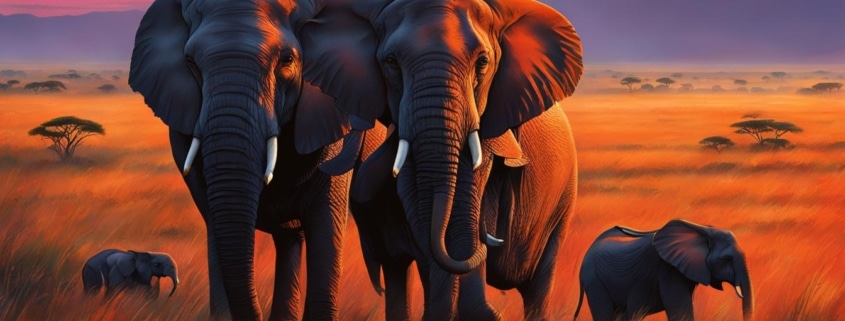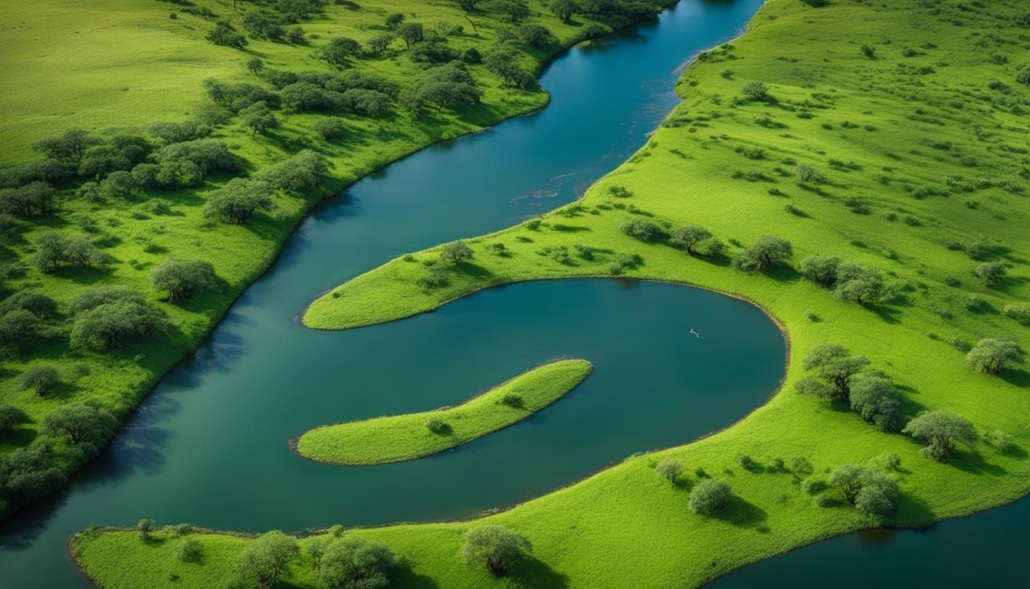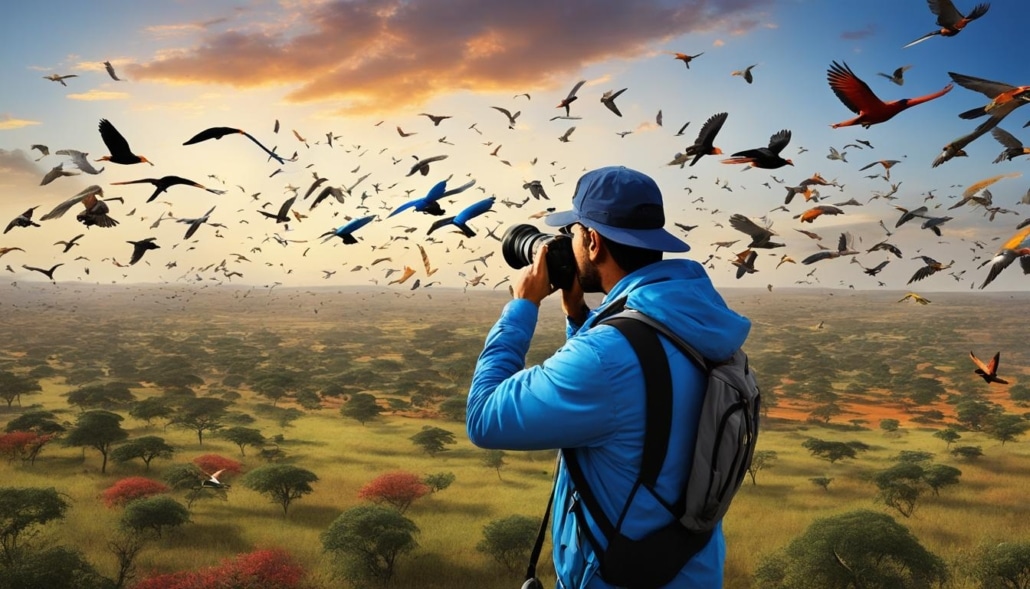Wildlife Safari in the Serengeti, Tanzania.
Embark on a thrilling Serengeti Safari and discover the breathtaking wonders of Tanzania’s Serengeti National Park. This iconic destination is a haven for wildlife enthusiasts, offering an unparalleled wildlife safari experience that is sure to leave you awe-inspired.
The Serengeti National Park is a World Heritage Site that spans over 14,763 square kilometers and is home to an incredible array of wildlife. With over 2 million ungulates, including wildebeest, zebras, and gazelles, as well as 4000 lions, 1000 leopards, 550 cheetahs, and 500 bird species, the park boasts an unrivaled biodiversity.
When it comes to safari options, the Serengeti offers something for everyone. From budget-friendly accommodations to luxurious lodges, you can find the perfect base for your adventure. Immerse yourself in the heart of the wild and experience the true essence of the Serengeti.
One of the park’s most iconic events is the Great Migration, where millions of wildebeest, zebras, and gazelles traverse the expansive savannah in search of greener pastures. Witnessing this awe-inspiring spectacle is an unforgettable experience that will stay with you forever.
Prepare to be captivated by the raw beauty of the Serengeti as you embark on an extraordinary wildlife safari. Explore the vast plains, encounter majestic predators, and traverse diverse ecosystems. This is your chance to connect with nature in its purest form.
Join us on an adventure of a lifetime and experience the magic of a wildlife safari in the Serengeti. Discover Tanzania’s natural treasures and create memories that will last a lifetime.
The Big Five in the Serengeti
The Serengeti National Park in Tanzania is renowned for its incredible wildlife, and at the forefront of it all are the Big Five. These iconic animals, consisting of lions, leopards, buffalo, elephants, and rhinoceros, represent the epitome of an African safari experience. Let’s dive into each of these magnificent creatures and discover why they hold such allure for visitors.
Lions: The Majestic Kings of the Savanna
Lions, known as the kings of the savanna, can easily be spotted in the Serengeti. They often gather in large prides, showcasing their incredible power and dominance. With their majestic manes and fierce roars, witnessing lions in their natural habitat is a truly awe-inspiring experience.
Leopards: The Elusive Spotted Cats
Leopards, on the other hand, are much more elusive. They are known for their exceptional climbing abilities and are often found resting in trees during the day, camouflaging themselves among the branches. Spotting a leopard in the Serengeti requires patience and a keen eye, making it all the more rewarding when you catch a glimpse of these magnificent creatures.
Buffalo: Formidable and Fearless
Buffalo, with their massive size and powerful horns, are one of the most dangerous animals in Africa. They have few natural predators and are known for their fiercely protective nature. Observing a herd of buffalo roaming the plains of the Serengeti is a humbling experience that showcases their raw strength and resilience.
Elephants: Gentle Giants of the African Wilderness
Elephants are the largest land animals in the world and possess an incredible intelligence and emotional depth. The Serengeti is home to a significant number of elephants, and observing these gentle giants in their natural habitat is a truly remarkable sight. Whether they are peacefully grazing or playfully splashing in waterholes, elephants never fail to captivate the hearts of visitors.
Rhinoceros: Prehistoric Wonders at Risk
Rhinoceros, with their prehistoric-looking appearance and formidable horns, have unfortunately faced significant threats due to poaching. The Serengeti is one of the last remaining sanctuaries for these incredible creatures. Spotting a rhinoceros in the wild is an unforgettable experience and a reminder of the urgent need for conservation efforts to protect these magnificent animals.
| Animal | Description |
|---|---|
| Lions | The kings of the savanna, easily spotted in large prides. |
| Leopards | Elusive cats often found resting in trees. |
| Buffalo | Huge and fearless animals that roam the Serengeti. |
| Elephants | Gentle giants with remarkable intelligence. |
| Rhinoceros | Prehistoric creatures at risk due to poaching. |
Spotting the Big Five in the Serengeti is a thrilling experience that immerses visitors in the beauty and wonder of the African wilderness. These incredible animals symbolize the untamed spirit of the Serengeti, making any safari journey unforgettable.
Wildlife and Other Attractions in the Serengeti
The Serengeti National Park is an awe-inspiring destination known for its incredible wildlife and diverse ecosystems. From majestic giraffes to mighty crocodiles, the park is a habitat for a wide variety of animals, making it a paradise for wildlife enthusiasts.
One of the most remarkable spectacles in the Serengeti is the wildebeest migration, where millions of wildebeest, zebras, and gazelles embark on a treacherous journey across the savannah in search of greener pastures. This extraordinary event attracts predators like lions and hyenas, creating thrilling scenes of predator-prey interactions.
The Grumeti and Mara Rivers play a crucial role during the wildebeest migration. These rivers become the gathering points for hippos and crocodiles, as they patiently wait for the wildebeests to make their daring river crossings. The sight of massive hippos and stealthy crocodiles coexisting in the same vicinity is a testament to the unique ecosystem of the Serengeti.
Aside from the captivating river scenes, the Serengeti is also home to lush riverine forests. These dense and verdant forests provide shelter and food for various wildlife, particularly the elusive giraffes. These towering creatures gracefully maneuver through the treetops, effortlessly dining on the leaves and absorbing the tranquility of their surroundings.
The Serengeti’s abundant wildlife is not confined to the riverine areas. Throughout the vast plains and acacia-dotted landscapes, antelope species such as impalas, gazelles, and elands roam freely, showcasing the park’s abundant biodiversity. The Serengeti truly offers a harmonious blend of open savannah, dense forests, and gentle hills, creating a mesmerizing backdrop for wildlife encounters.
| Wildlife | Attractions |
|---|---|
| Giraffes | Graceful creatures of the Serengeti, often found in riverine forests. |
| Hippos | Fascinating semi-aquatic animals that gather in the rivers, especially during the wildebeest migration. |
| Crocodiles | Fierce predators commonly found in the rivers, awaiting their next meal. |
| Antelope species | A wide variety of antelopes thrive in the open plains and savannahs of the Serengeti. |
Exploring the Serengeti allows visitors to witness the intricate balance of nature and the coexistence of species in this unique transition area. The park’s stunning wildlife and breathtaking landscapes offer a deep connection to the wonders of the natural world, making it an unforgettable destination for any nature lover.
Birdlife and Insects in the Serengeti
The Serengeti National Park is not only a haven for large mammals but also a paradise for birdwatching enthusiasts. With over 500 bird species recorded in the park, there is always something fascinating to observe in the sky or perched on a branch.
From November to April, the Serengeti welcomes European and North African migratory birds. These seasonal visitors add an extra layer of diversity to the bird population, creating a unique spectacle for birdwatchers. During this time, resident species also breed and showcase their vibrant plumage.
Insects, too, are abundant in the Serengeti and play a crucial role in the park’s biodiversity. While the number of stinging and biting insects is relatively low, the diversity of other insect groups is astonishing. From dung beetles diligently recycling animal waste to colorful butterflies fluttering through the grass, the Serengeti is a bustling ecosystem where insects thrive.
The following table provides a glimpse into the birdlife and insect diversity found in the Serengeti:
| Bird Species | Insect Groups |
|---|---|
| Secretary Bird | Dung Beetles |
| Lilac-breasted Roller | Grasshoppers |
| Grey Crowned Crane | Termites |
| Fischer’s Lovebird | Butterflies |
| African Fish Eagle | Moths |
| Pied Kingfisher | Ants |
Whether your passion lies in birdwatching or marveling at the intricate world of insects, the Serengeti offers endless opportunities to immerse yourself in the wonders of nature. Don’t forget to bring your binoculars or macro lens to capture the intricate details of these remarkable creatures.
Witness the Colors of Serengeti Birds
“The beauty of birds is that they can bring color to even the vastest landscapes, painting the Serengeti sky with their vibrant plumage.” – Naturalist Jane Goodall
Conclusion
The Serengeti National Park in Tanzania is a true paradise for wildlife enthusiasts and nature lovers. With its vast landscapes, diverse ecosystems, and abundant wildlife, it offers an unforgettable safari adventure. Whether you dream of spotting the iconic Big Five or witnessing the awe-inspiring Great Migration, the Serengeti has it all.
Exploring the open plains, you’ll encounter majestic lions, elusive leopards, massive herds of wildebeest, and an array of other fascinating wildlife. The park’s riverine forests also provide unique opportunities to observe giraffes gracefully moving through the trees, while hippos and crocodiles bask along the riverbanks.
As you venture through the Serengeti, the rich birdlife and diverse insect population will captivate you. With over 500 bird species, including migratory birds from Europe and North Africa, the park is a haven for birdwatchers. Insects play a crucial role in the ecosystem, showcasing the incredible biodiversity found in this natural wonderland.
For those seeking a safari adventure like no other, the Serengeti National Park is a must-visit destination. Immerse yourself in the raw beauty of this extraordinary park, where wildlife encounters, stunning landscapes, and the wonders of nature await.
FAQ
What is the best time to visit the Serengeti for a wildlife safari?
The best time to visit the Serengeti for a wildlife safari is during the Great Migration, which occurs from June to October. This is when millions of wildebeest, zebras, and gazelles travel across the savannah, providing incredible wildlife viewing opportunities. However, the Serengeti is a year-round destination with abundant wildlife, so you can plan your visit based on personal preferences.
What are the accommodation options available in the Serengeti?
The Serengeti offers a variety of accommodation options, ranging from budget-friendly campsites to luxury lodges. There are also mid-range tented camps and permanent camps that provide a more comfortable stay while immersing you in the wilderness. Whether you prefer a more rustic experience or lavish accommodations, there are options available to suit different budgets and preferences.
Are there any safety precautions to keep in mind while on a safari in the Serengeti?
While the Serengeti is a safe destination for wildlife safaris, it’s essential to follow your guide’s instructions and maintain a safe distance from the animals. It’s also important to take precautions against insect bites (such as using insect repellent and wearing long-sleeved clothing) and to have appropriate travel insurance. Always listen to the advice of experienced guides and rangers to ensure a safe and enjoyable safari experience.
What wildlife can I expect to see in the Serengeti?
The Serengeti is home to a diverse range of wildlife, including the Big Five (lions, leopards, buffalo, elephants, and rhinoceros). You can also spot giraffes, hippos, crocodiles, a variety of antelope species, and numerous bird species. The park’s stunning landscapes and diverse ecosystems provide abundant opportunities for wildlife viewing and photography.
How do I reach the Serengeti National Park?
The most common way to reach the Serengeti National Park is by flying into one of the nearby airports, such as Kilimanjaro International Airport or Julius Nyerere International Airport, and then transferring to the park. There are also domestic flights available from these airports to airstrips within the park. Alternatively, you can also reach the Serengeti by road, either through a guided safari tour or by self-driving.






Leave a Reply
Want to join the discussion?Feel free to contribute!